
Tetrahedral symmetry
Encyclopedia

Tetrahedron
In geometry, a tetrahedron is a polyhedron composed of four triangular faces, three of which meet at each vertex. A regular tetrahedron is one in which the four triangles are regular, or "equilateral", and is one of the Platonic solids...
has 12 rotational (or orientation-preserving) symmetries, and a symmetry order of 24 including transformations that combine a reflection and a rotation.
The group of all symmetries is isomorphic to the group S4, symmetric group
Symmetric group
In mathematics, the symmetric group Sn on a finite set of n symbols is the group whose elements are all the permutations of the n symbols, and whose group operation is the composition of such permutations, which are treated as bijective functions from the set of symbols to itself...
, as a permutations of four objects, since there is exactly one such symmetry for each permutation of the vertices of the tetrahedron. The set of orientation-preserving symmetries forms a group referred to as the alternating subgroup A4 of S4.
Details
Chiral and full (or achiral) tetrahedral symmetry and pyritohedral symmetry are discrete point symmetriesPoint groups in three dimensions
In geometry, a point group in three dimensions is an isometry group in three dimensions that leaves the origin fixed, or correspondingly, an isometry group of a sphere. It is a subgroup of the orthogonal group O, the group of all isometries that leave the origin fixed, or correspondingly, the group...
(or equivalently, symmetries on the sphere). They are among the crystallographic point groups of the cubic crystal system.
Chiral tetrahedral symmetry

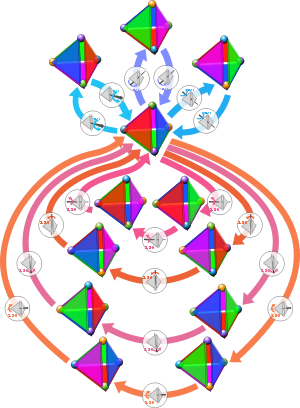
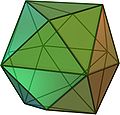
Dihedral symmetry in three dimensions
This article deals with three infinite sequences of point groups in three dimensions which have a symmetry group that as abstract group is a dihedral group Dihn .See also point groups in two dimensions.Chiral:...
D2 or 222, with in addition four 3-fold axes, centered between the three orthogonal directions. This group is isomorphic to A4, the alternating group on 4 elements; in fact it is the group of even permutations of the four 3-fold axes: e, (123), (132), (124), (142), (134), (143), (234), (243), (12)(34), (13)(24), (14)(23).
The conjugacy class
Conjugacy class
In mathematics, especially group theory, the elements of any group may be partitioned into conjugacy classes; members of the same conjugacy class share many properties, and study of conjugacy classes of non-abelian groups reveals many important features of their structure...
es of T are:
- identity
- 4 × rotation by 120° clockwise (seen from a vertex): (234), (143), (412), (321)
- 4 × rotation by 120° anti-clockwise (ditto)
- 3 × rotation by 180°
The rotations by 180°, together with the identity, form a normal subgroup
Normal subgroup
In abstract algebra, a normal subgroup is a subgroup which is invariant under conjugation by members of the group. Normal subgroups can be used to construct quotient groups from a given group....
of type Dih2, with quotient group
Quotient group
In mathematics, specifically group theory, a quotient group is a group obtained by identifying together elements of a larger group using an equivalence relation...
of type Z3. The three elements of the latter are the identity, "clockwise rotation", and "anti-clockwise rotation", corresponding to permutations of the three orthogonal 2-fold axes, preserving orientation.
A4 is the smallest group demonstrating that the converse of Lagrange's theorem
Lagrange's theorem (group theory)
Lagrange's theorem, in the mathematics of group theory, states that for any finite group G, the order of every subgroup H of G divides the order of G. The theorem is named after Joseph Lagrange....
is not true in general: given a finite group G and a divisor d of |G|, there does not necessarily exist a subgroup of G with order d: the group G = A4 has no subgroup of order 6. Although it is a property for the abstract group in general, it is clear from the isometry group of chiral tetrahedral symmetry: because of the chirality the subgroup would have to be C6 or D3, but neither applies.
Achiral tetrahedral symmetry
Td, *332, [3,3] or , of order 24 - achiral or full tetrahedral symmetry, also known as the (2,3,3) triangle group
, of order 24 - achiral or full tetrahedral symmetry, also known as the (2,3,3) triangle groupTriangle group
In mathematics, a triangle group is a group that can be realized geometrically by sequences of reflections across the sides of a triangle. The triangle can be an ordinary Euclidean triangle, a triangle on the sphere, or a hyperbolic triangle...
. This group has the same rotation axes as T, but with six mirror planes, each through two 3-fold axes. The 2-fold axes are now S4 (
 ) axes. Td and O are isomorphic as abstract groups: they both correspond to S4, the symmetric group
) axes. Td and O are isomorphic as abstract groups: they both correspond to S4, the symmetric groupSymmetric group
In mathematics, the symmetric group Sn on a finite set of n symbols is the group whose elements are all the permutations of the n symbols, and whose group operation is the composition of such permutations, which are treated as bijective functions from the set of symbols to itself...
on 4 objects. Td is the union of T and the set obtained by combining each element of O \ T with inversion. See also the isometries of the regular tetrahedron.
The conjugacy classes of Td are:
- identity
- 8 × rotation by 120°
- 3 × rotation by 180°
- 6 × reflection in a plane through two rotation axes
- 6 × rotoreflection by 90°
Subgroups
- Td
- T
- D2d
- D2
- C3v and C2v
- C3 and C2
- S4
- E and Cs
Pyritohedral symmetry
Th, 3*2, [4,3+] or m3, of order 24 - pyritohedral symmetry. This group has the same rotation axes as T, with mirror planes through two of the orthogonal directions. The 3-fold axes are now S6 ( ) axes, and there is inversion symmetry. Th is isomorphic to T × Z2: every element of Th is either an element of T, or one combined with inversion. Apart from these two normal subgroups, there is also a normal subgroup D2h (that of a cuboid
) axes, and there is inversion symmetry. Th is isomorphic to T × Z2: every element of Th is either an element of T, or one combined with inversion. Apart from these two normal subgroups, there is also a normal subgroup D2h (that of a cuboidCuboid
In geometry, a cuboid is a solid figure bounded by six faces, forming a convex polyhedron. There are two competing definitions of a cuboid in mathematical literature...
), of type Dih2 × Z2 = Z2 × Z2 × Z2 . It is the direct product of the normal subgroup of T (see above) with Ci
Inversion (geometry)
In geometry, inversive geometry is the study of those properties of figures that are preserved by a generalization of a type of transformation of the Euclidean plane, called inversion...
. The quotient group
Quotient group
In mathematics, specifically group theory, a quotient group is a group obtained by identifying together elements of a larger group using an equivalence relation...
is the same as above: of type Z3. The three elements of the latter are the identity, "clockwise rotation", and "anti-clockwise rotation", corresponding to permutations of the three orthogonal 2-fold axes, preserving orientation.
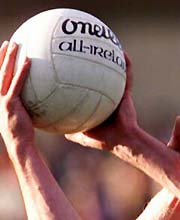
Pyritohedron
In geometry, a pyritohedron is an irregular dodecahedron with pyritohedral symmetry. Like the regular dodecahedron, it has twelve identical pentagonal faces, with three meeting in each of the 20 vertices. However, the pentagons are not regular, and the structure has no fivefold symmetry axes...
, which is extremely similar to the cube described, with each rectangle replaced by a pentagon with one symmetry axis and 4 equal sides and 1 different side (the one corresponding to the line segment dividing the cube's face); i.e., the cube's faces bulge out at the dividing line and become narrower there. It is a subgroup of the full icosahedral symmetry
Icosahedral symmetry
A regular icosahedron has 60 rotational symmetries, and a symmetry order of 120 including transformations that combine a reflection and a rotation...
group (as isometry group, not just as abstract group), with 4 of the 10 3-fold axes.
The conjugacy classes of Th include those of T, with the two classes of 4 combined, and each with inversion:
- identity
- 8 × rotation by 120°
- 3 × rotation by 180°
- inversion
- 8 × rotoreflection by 60°
- 3 × reflection in a plane
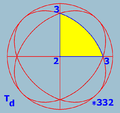

Subgroups
- Th
- T
- D2h
- D2
- C2h
- C2v
- C3 and C2
- S6 and S2=Ci
- E and Cs
Solids with chiral tetrahedral symmetry

The Icosahedron colored as a snub tetrahedron has chiral symmetry.
Platonic solid
| Name | Picture | Faces | Edges | Vertices | Edges per face | Faces meeting at each vertex |
|---|---|---|---|---|---|---|
| tetrahedron Tetrahedron In geometry, a tetrahedron is a polyhedron composed of four triangular faces, three of which meet at each vertex. A regular tetrahedron is one in which the four triangles are regular, or "equilateral", and is one of the Platonic solids... |
 (Animation) |
4 | 6 | 4 | 3 | 3 |
Archimedean solid
(semi-regular: vertex-uniform)| Name | picture | Faces | Edges | Vertices | Vertex configuration | |
|---|---|---|---|---|---|---|
| truncated tetrahedron Truncated tetrahedron In geometry, the truncated tetrahedron is an Archimedean solid. It has 4 regular hexagonal faces, 4 regular triangular faces, 12 vertices and 18 edges.- Area and volume :... |
 |
8 | 4 triangles 4 hexagons |
18 | 12 | 3,6,6 |
Catalan solid
(semi-regular dual: face-uniform)| Name | picture | Dual Archimedean solid | Faces | Edges | Vertices | Face polygon |
|---|---|---|---|---|---|---|
| triakis tetrahedron Triakis tetrahedron In geometry, a triakis tetrahedron is an Archimedean dual solid, or a Catalan solid. Its dual is the truncated tetrahedron.It can be seen as a tetrahedron with triangular pyramids added to each face; that is, it is the Kleetope of the tetrahedron... | 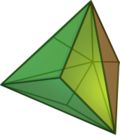 (Video) | truncated tetrahedron Truncated tetrahedron In geometry, the truncated tetrahedron is an Archimedean solid. It has 4 regular hexagonal faces, 4 regular triangular faces, 12 vertices and 18 edges.- Area and volume :... | 12 | 18 | 8 | isosceles triangle |
Nonconvex uniform polyhedron
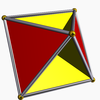 Tetrahemihexahedron Tetrahemihexahedron In geometry, the tetrahemihexahedron or hemicuboctahedron is a uniform star polyhedron, indexed as U4. It has 6 vertices and 12 edges, and 7 faces: 4 triangular and 3 square. Its vertex figure is a crossed quadrilateral. It has Coxeter-Dynkin diagram of .... |
 Octahemioctahedron Octahemioctahedron In geometry, the octahemioctahedron is a nonconvex uniform polyhedron, indexed as U3. Its vertex figure is a crossed quadrilateral.It is one of nine hemipolyhedra with 4 hexagonal faces passing through the model center.- Related polyhedra :... |
See also
- octahedral symmetryOctahedral symmetry150px|thumb|right|The [[cube]] is the most common shape with octahedral symmetryA regular octahedron has 24 rotational symmetries, and a symmetry order of 48 including transformations that combine a reflection and a rotation...
- icosahedral symmetryIcosahedral symmetryA regular icosahedron has 60 rotational symmetries, and a symmetry order of 120 including transformations that combine a reflection and a rotation...
- binary tetrahedral group

